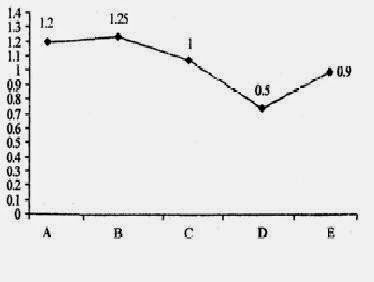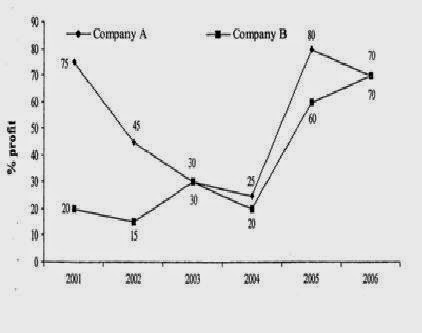Directions (1-5): In a company there are five different departments (A, B, C, D and E). In each department, a certain number of male and female employees are working. The given bar chart shows the number of employees working in each department and the line graph shows the ratio of male to female workers in each department.
Ratio b/w Male & Female
1. What is the difference between the toal numbers of male and female employees in the company?
1) 34 2) 24 3) 14
4) 4 5) 0
2. What is the ratio of male to female employees working in department B?
1) 4 : 5 2) 5 : 4 3) 3 : 5
4) 5 : 3 5) 3 : 2
3. What is the average number of male employees working in all the five departments?
1) 60 2) 70 3) 80
4) 50 5) 90
4. The number of male employees working in department A is what percentage more than that working in department B?
1) 20% 2) 25% 3) 30%
4) 40% 5) 50%
5. What is the ratio of the difference between the number of female and male employees in department D to that in department E?
1) 2 : 3 2) 3 : 1 3) 3 : 2
4) 1 : 3 5) None of these
Directions (6-10): The expenditure and percentage profit of two companies A and B for six years in the period 2001-2006 are shown in the given bar graph and line graph. The expenditure is given in lakhs.
6. What is the difference between the average expenditure of Company A from 2001 to 2006 and that of Company B?
1) Rs 60 lakhs
2) Rs 45 lakhs
3) Rs 30 lakhs
4) Rs 15 lakhs
5) Rs 10 lakhs
7. In how many of the given years is the income of Company A more than Rs 100 lakhs?
1) Four
2) Three
3) Two
4) One
5) None
8. In how many years is the profit of Company B more than Rs 10 lakhs?
1) Five
2) Four
3) Three
4) Two
5) One
9. In 2004, the income of Company B is what percentage more than the income of Company A?
1) 32%
2) 24%
3) 16%
4) 12%
5) 8%
10. What is the ratio of the income of Company B in 2004 to that of Company A in 2005?
1) 9 : 13
2) 13 : 9
3) 11 : 9
4) 13 : 11
5) 5 : 4
Answers:
1. (4) 2. (2) 3. (2) 4. (5) 5. (2)
6. (5) 7. (4) 8. (4) 9. (1) 10 (3)
1. (4) 2. (2) 3. (2) 4. (5) 5. (2)
6. (5) 7. (4) 8. (4) 9. (1) 10 (3)
Solutions (6-10)
6. (5) Total expenditure of A = 270
Average expenditure = 270 / 6 = 45
Total expenditure of B = 210
Average expenditure = 210 / 6 = 35
Difference = 45 – 35 = 10
7. (4) In 2001, profit = (60 x 75) / 100 = 45
Income = 60 + 45 = 105 lakhs
8. (4) In 2006 = (25x170) / 100 = 42.5 lakh
Profit = 42.5 – 25 lakh = Rs 17.5 lakhs
In 2004 Profit is 18 lakh
9. (1) In 2004 and 2006
In 2004, income of A = 50 lakhs
In 2004, income of B = 66 lakhs
Req percentage = (66 – 50) / 50 X 100 = 32%
10. (3) In 2004, income of B = 66 lakhs
In 2005, income of A = 54 lakhs
Req Ratio: 66 : 54 = 11 : 9
For more Updates & Notifications for bank exams like SBI PO, SBI CLERK, IBPS PO, IBPS RRB, IBPS CLERK, IBPS SO, NIACL, SSC CHSL, SSC CGL etc. like our facebook page at :














0 comments:
Post a Comment